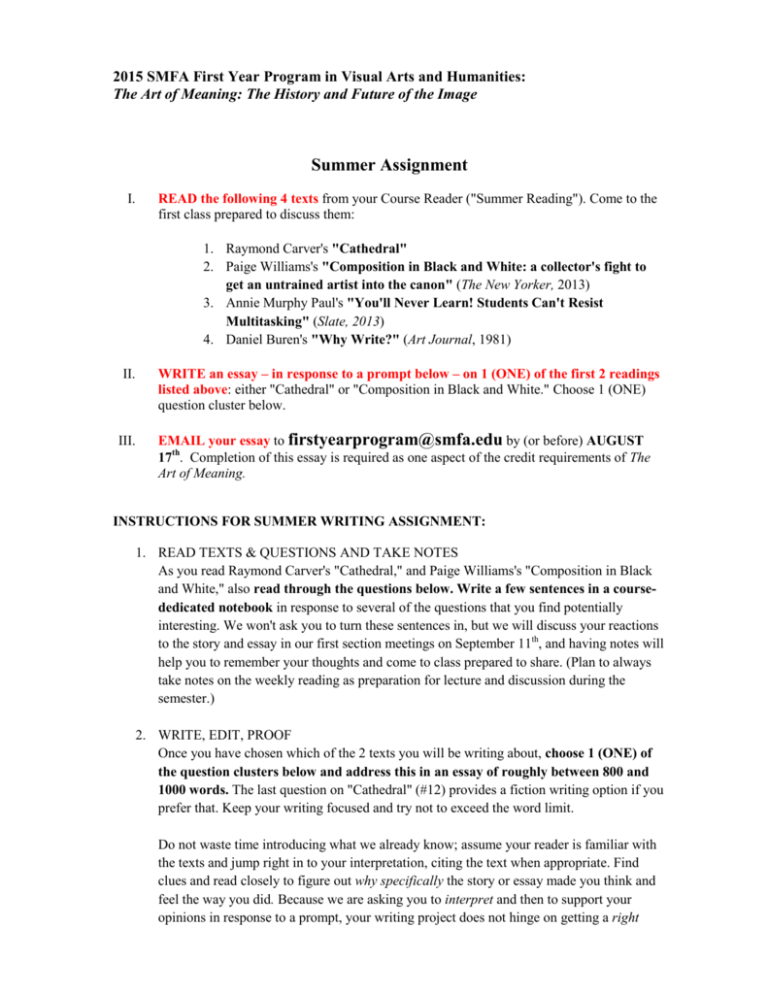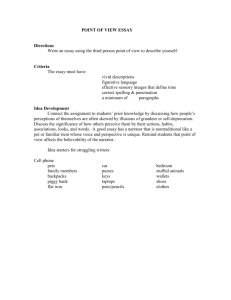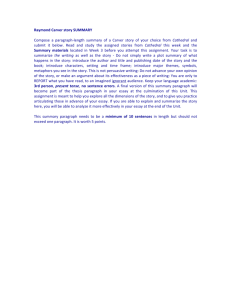FYP Summer Assignment 2015 - School of the Museum of Fine Arts
advertisement

2015 SMFA First Year Program in Visual Arts and Humanities: The Art of Meaning: The History and Future of the Image Summer Assignment I. READ the following 4 texts from your Course Reader ("Summer Reading"). Come to the first class prepared to discuss them: 1. Raymond Carver's "Cathedral" 2. Paige Williams's "Composition in Black and White: a collector's fight to get an untrained artist into the canon" (The New Yorker, 2013) 3. Annie Murphy Paul's "You'll Never Learn! Students Can't Resist Multitasking" (Slate, 2013) 4. Daniel Buren's "Why Write?" (Art Journal, 1981) II. III. WRITE an essay – in response to a prompt below – on 1 (ONE) of the first 2 readings listed above: either "Cathedral" or "Composition in Black and White." Choose 1 (ONE) question cluster below. EMAIL your essay to firstyearprogram@smfa.edu by (or before) AUGUST 17th. Completion of this essay is required as one aspect of the credit requirements of The Art of Meaning. INSTRUCTIONS FOR SUMMER WRITING ASSIGNMENT: 1. READ TEXTS & QUESTIONS AND TAKE NOTES As you read Raymond Carver's "Cathedral," and Paige Williams's "Composition in Black and White," also read through the questions below. Write a few sentences in a coursededicated notebook in response to several of the questions that you find potentially interesting. We won't ask you to turn these sentences in, but we will discuss your reactions to the story and essay in our first section meetings on September 11th, and having notes will help you to remember your thoughts and come to class prepared to share. (Plan to always take notes on the weekly reading as preparation for lecture and discussion during the semester.) 2. WRITE, EDIT, PROOF Once you have chosen which of the 2 texts you will be writing about, choose 1 (ONE) of the question clusters below and address this in an essay of roughly between 800 and 1000 words. The last question on "Cathedral" (#12) provides a fiction writing option if you prefer that. Keep your writing focused and try not to exceed the word limit. Do not waste time introducing what we already know; assume your reader is familiar with the texts and jump right in to your interpretation, citing the text when appropriate. Find clues and read closely to figure out why specifically the story or essay made you think and feel the way you did. Because we are asking you to interpret and then to support your opinions in response to a prompt, your writing project does not hinge on getting a right answer. Instead, use the assignment to frame or illuminate something that interests you about the story or essay. 3. POLISH YOUR WRITING Be sure to include at the top of your first page your name, the text, and the question cluster you are writing in response to. Before you email us your essay, edit, revise, and proofread your writing. QUESTIONS ABOUT RAYMOND CARVER'S "CATHEDRAL": 1.) Why – and how – do you think the cathedral functions as an important image or symbol in the story? What added dimension does this symbol bring to our understanding of the story? Can you relate this to the story's treatment of the artistic process? 2.) Can "Cathedral" be read as a story about art and creativity and/or what happens in its absence? Where do you see evidence for this in the text? Consider the drawing experience that occurs at the end of the story, and perhaps relate this to other artistic endeavors in the story. Music? Poetry? What does the story suggest to you about how art can function in human lives? 3.) In what ways is this story about communication and connectedness – and what does this have to do with art, according to this story? Consider the poems, the tapes, the ham radio, etc. 4.) For Carver, human contact and connection are at the center of life. What details from the story allow you to challenge or confirm this idea? 5.) What does Robert “see” over the course of the evening? How does this story redefine the narrator's (our own?) understanding of “seeing”? 6.) What is important about the references to the narrator's wife's poems and tapes? How do these aspects of the story shape its perspective/s on the creative process? 7.) What is the narrator’s attitude toward his wife? Describe the narrator’s marriage. Is the narrator’s jealousy of Robert irrational? If not, why not? Connect your thoughts about this to the role of art in – and not in – these characters' lives? 8.) How does Robert shatter the narrator’s preconceived notions of blind people? How do his appearance and bearing resist every stereotypical image the narrator has about blind people, and, crucially, why is this so unsettling for the narrator, do you think? 9.) What does the narrator learn from his encounter with Robert? Be sure to address why and how drawing has been a central part of this experience. 10.) Describe Carver’s style, and analyze how this might relate to any of the story's ideas. 11.) What are the different roles that alcohol & marijuana play in the story? Do they play more than one role? How does your interpretation of these illuminate something about the central themes in the story? 12.) IF YOU WOULD RATHER WRITE YOUR OWN SHORT FICTION IN RESPONSE: Create a conversation between the narrator and his wife after Robert’s departure. Be sure that this dialogue reveals something about the events that have preceded it. QUESTIONS ABOUT PAIGE WILLIAMS'S "COMPOSITION IN BLACK AND WHITE": 1.) Who or what determines what counts as art? Many museums have become more and more interested in "Outsider Art," a term that has come to replace and perhaps refigure the term "Folk Art." As the Milwaukee Art Museum describes it, Outsider Art implies "forms of creative expression that exist outside accepted cultural norms, or the realm of 'fine art.'" Without worrying too much about the specific history of this term, write an essay in which you discuss how this article enables you to think about the role/s of and, more specifically, the power of the museum for visual culture producers. Note that since the article was written, the Met (Metropolitan Museum of Art in New York City) did indeed purchase 10 works by Thornton Dial last November as well as some other pieces in William Arnett's Souls Grown Deep collection. 2.) How does the curatorial relationship, broadly understood, influence artists and the production of art itself? Although William Arnett has served as a patron of rural artists from the South who are largely poor and often African American, "Composition in Black and White" doesn't attempt to tell us what to think about the issues it explores in any simple way. Write an essay that demonstrates your understanding of and your opinion about this curatorial relationship, specifically addressing the roles of race and economic class at play. Your essay should consider both why some people have been critical of Arnett's role in Thornton Dial's life and why others have celebrated Arnett and Dial together for what their relationship has brought forth. A strong essay will argue a position, while understanding – and in some cases countering – opposing points. 3.) Write an essay in which you explain why this essay might be important for contemporary artists to consider. What issues does it raise that you think are important at this moment for producers of visual culture?




